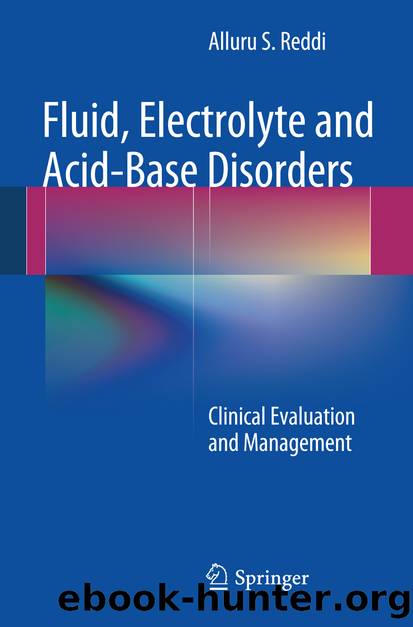Fluid, Electrolyte and Acid-Base Disorders by Alluru S. Reddi

Author:Alluru S. Reddi
Language: eng
Format: epub
Publisher: Springer New York, New York, NY
Discontinuation of vitamin D, hydration, bisphosphonates, and low calcium diet improve hypercalcemia
Clinical Manifeststions
As Ca2+ is needed for functions of all organs, hypercalcemia affects all organ systems. The signs and symptoms of hypercalcemia depend on the severity and rate of rise of Ca2+ levels. Depending on serum Ca2+ levels, hypercalcemia is classified into mild (10.5–11.9 mg/dL), moderate (12–13.9 mg/dL), and severe (> 14 mg/dL) hypercalcemia. Renal and neurologic manifestations worsen with increasing severity of hypercalcemia. Also, a rapid development of mild to moderate hypercalcemia results in severe neurologic dysfunction. In contrast, chronic hypercalcemia may cause minimal neurologic signs and symptoms. Mild hypercalcemia may be asymptomatic in younger individuals, but may have profound effect in the elderly because of preexisting neurologic and cognitive dysfunction. Table 19.4 lists signs and symptoms of hypercalcemia.
Table 19.4Clinical manifestations of hypercalcemia
Download
This site does not store any files on its server. We only index and link to content provided by other sites. Please contact the content providers to delete copyright contents if any and email us, we'll remove relevant links or contents immediately.
When Breath Becomes Air by Paul Kalanithi(7253)
Why We Sleep: Unlocking the Power of Sleep and Dreams by Matthew Walker(5636)
Paper Towns by Green John(4163)
The Immortal Life of Henrietta Lacks by Rebecca Skloot(3819)
The Sports Rules Book by Human Kinetics(3581)
Dynamic Alignment Through Imagery by Eric Franklin(3481)
ACSM's Complete Guide to Fitness & Health by ACSM(3459)
Kaplan MCAT Organic Chemistry Review: Created for MCAT 2015 (Kaplan Test Prep) by Kaplan(3418)
Introduction to Kinesiology by Shirl J. Hoffman(3297)
Livewired by David Eagleman(3113)
The River of Consciousness by Oliver Sacks(2988)
Alchemy and Alchemists by C. J. S. Thompson(2908)
The Death of the Heart by Elizabeth Bowen(2895)
Descartes' Error by Antonio Damasio(2727)
Bad Pharma by Ben Goldacre(2722)
The Gene: An Intimate History by Siddhartha Mukherjee(2487)
Kaplan MCAT Behavioral Sciences Review: Created for MCAT 2015 (Kaplan Test Prep) by Kaplan(2483)
The Fate of Rome: Climate, Disease, and the End of an Empire (The Princeton History of the Ancient World) by Kyle Harper(2429)
The Emperor of All Maladies: A Biography of Cancer by Siddhartha Mukherjee(2427)
